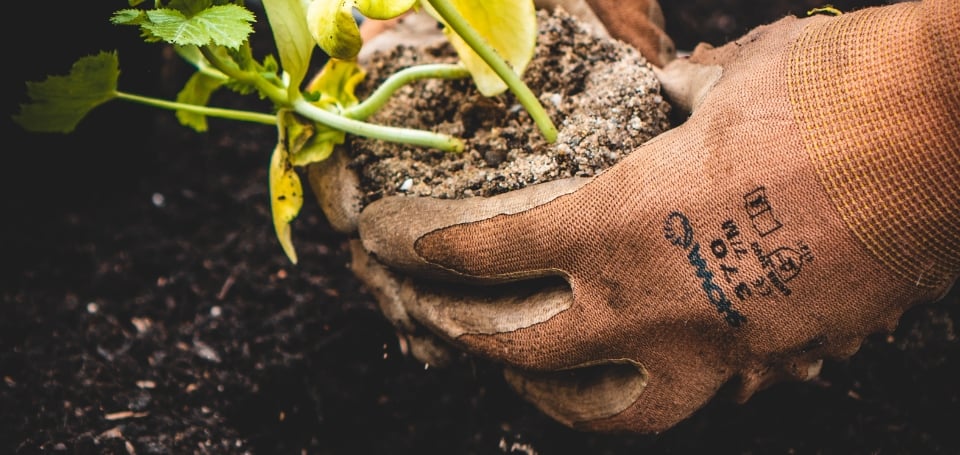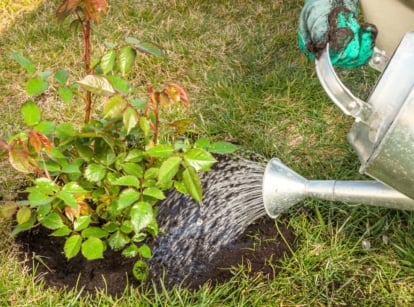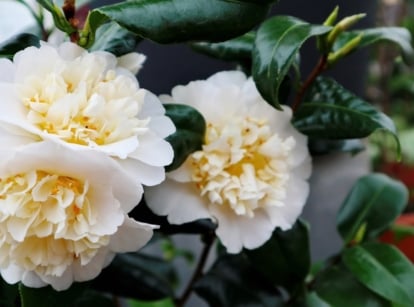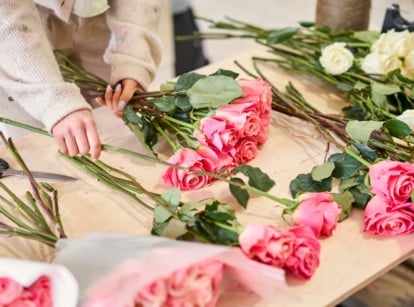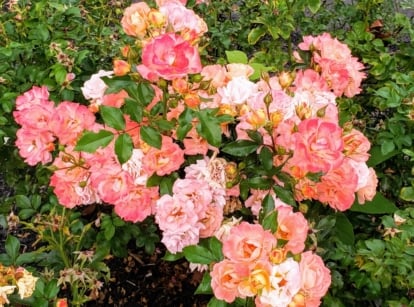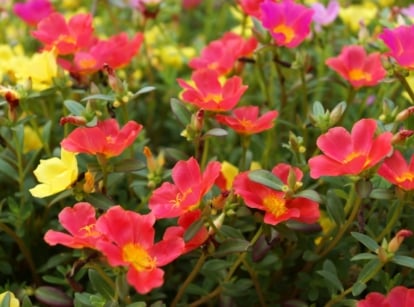7 Tips for Growing Climbing Roses in Pots and Containers
You don't have to have tons of space to grow climbing roses. Many of them grow well in containers, so you can grow them in smaller spaces and on patios, too! Gardening expert Melissa Strauss has some tips on successfully growing climbers and ramblers in containers.

Contents
Climbing rose varieties tend to be big bloomers that are easy to grow and care for in containers. That’s not to say they are necessarily low maintenance, but the payoff tends to be worth the effort, as they typically grow quickly and produce a great quantity of flowers. They also take up a lot of space and need their fair share of resources.
If you are a small space or patio gardener or need your climbing rose to be portable, there are many considerations to take into account. While it’s not impossible, growing a climbing rose in a container requires significant attention and planning. From the soil to the support, you’ll want to take every aspect into consideration when growing one of these large plants in a pot.
If you have limited space or simply want to grow your climber in a pot, there are steps you can take that will set you firmly on the path to success. Let’s talk about some important factors for keeping your rambling rose happy in a container.
Choose the Right Rose

The place to begin when growing a climbing rose in a container is the specific type of rose. Some climbers, also called ramblers, grow so large that a container is impractical. Fortunately, there are quite a number of plants that are appropriate for this purpose. Naturally, a cultivar that grows to a manageable height is a good call. A plant that grows 25 feet tall can be problematic.
English roses tend to have a lot of stems that begin at the base. This creates a shrubby plant that looks nice at the level of the container, rather than having thicker, sparser canes that form thick trunks over time. Miniatures are good for containers, as they are hardy and easy to care for. They’re not usually as cold-tolerant as larger varieties.
Here are some wonderful examples of cultivars that perform well in a pot, as opposed to the ground:
‘Strawberry Hill’

|
|
common name ‘Strawberry Hill’ |
|---|---|
|
|
botanical name Rosa ‘Ausrimini’PBR |
|
|
sun requirements Full sun |
|
|
height 10’ |
|
|
hardiness zones 5-10 |
‘Strawberry Hill’ is a beautiful David Austin cultivar with pretty pink blooms that have a moderate to strong myrrh fragrance. It grows to about ten feet tall and is great for a container that you want to be more portable. The flowers are large for a climber, and it’s a repeat bloomer, so deadhead spent flowers if you want multiple flushes.
‘Suffolk’

|
|
common name ‘Suffolk’ |
|---|---|
|
|
botanical name Rosa ‘KORmixal’ |
|
|
sun requirements Full sun |
|
|
height 4’ |
|
|
hardiness zones 6-9 |
‘Suffolk’ is technically not a climber but a ground cover. However, you can easily train it to climb a small support. This is a great patio cultivar as it remains smaller than most. It’s less cold tolerant than most, so in cooler climates, you’ll want to bring it indoors for the winter. Flowers are crimson and single, with little to no fragrance.
‘White Lady Banks’

|
|
common name ‘White Lady Banks’ |
|---|---|
|
|
botanical name Rosa banksiae ‘Alba Plena’ |
|
|
sun requirements Full sun to partial shade |
|
|
height 10’-20’ |
|
|
hardiness zones 6-9 |
‘White Lady Banks’ is a miniature climbing variety that grows to an average of ten feet tall, though it can grow taller. It blooms profusely in spring to early summer with small, double-blooming, white flowers that are lightly fragrant. It’s a fast grower and performs well in a container.
‘Dublin Bay’

|
|
common name ‘Dublin Bay’ |
|---|---|
|
|
botanical name Rosa ‘Macdub’ |
|
|
sun requirements Full sun |
|
|
height 8’-12’ |
|
|
hardiness zones 6-9 |
‘Dublin Bay’ is a beautiful, red, repeat-blooming cultivar with a light fragrance. It’s considered a good beginner rose and grows to between eight and 12 feet tall. It’s great for growing in a pot and is moveable if need be. It blooms around June and continues in flushes, ending around October.
Use A Large Container

Roses tend to have extensive but shallow root systems, which makes container growing a challenge. The key to success is choosing a pot that is large enough to contain the root system. Since a large, wide container is difficult to find, go for one that is deep, as the roots will grow downward when they cannot spread farther.
Look for a container that is at least two feet deep and wide and about 15-20 gallons in volume. That’s pretty large and may be difficult to find in big stores that don’t specialize in plants. A local nursery may be a better place to look.
Use High-Quality Soil

Roses like heavy soil that holds moisture and contains ample nutrients. I recommend paying attention to the type of soil you use and not skimping in this area. A high-quality potting soil will make a difference in the long term.
If you prefer to make your own soil, start with a loam-heavy base. Combine equal parts of your soil with composted manure and garden compost. Stir in some bone meal for extra nutrients and perlite or pumice to improve drainage.
Water Frequently

The rule for roses planted in the ground is to water deeply and infrequently. Because potted plants dry out faster, this isn’t the best practice for their care. Your container full of soil only holds a certain amount of moisture. As a result, it will dry faster, especially in hot weather.
As your plant grows larger, its moisture needs also increase. It’s difficult to put an exact time frame on how often you should water because there are several factors that come into play. Number one, the size of the container determines how much soil it will hold. The type of soil determines how much water it will hold. So, the volume and type of soil determine how much moisture you can give your rose at one time.
The weather is another major factor in the evaporation, and therefore the water needs of your plant. In hot weather, water evaporates faster. This means your soil will dry out faster. Finally, the size of the rose matters, as a larger plant needs more water, and will absorb it faster.
It’s hard to say that you should water once or twice weekly or even daily. Because some of these factors are variable, the amount of water will change over time and throughout the seasons.
A better method is to regularly check your soil, and make sure that it doesn’t dry out completely. Also, water deeply when you do. Make sure to thoroughly soak the soil until the water runs out the drainage holes.
Fertilize Often

As I mentioned, roses are heavy feeders. Because your pot has less soil to store those nutrients, you’ll need to fertilize your rose more often than one planted in the ground. The type of fertilizer you use also makes a difference in frequency. A liquid fertilizer will work faster but won’t last as long. A granular, slow-release fertilizer lasts longer but delivers nutrients more slowly.
I favor slow-release fertilizers for larger plants like roses. These provide more consistent nutrients over a longer time. Choose a balanced formula or one made specifically for roses. A rose-specific fertilizer will typically have a higher middle number in the ratio, which indicates that it contains more phosphorus.
During the growing season, which is spring and summer, apply your granular fertilizer every four to six weeks. If using a liquid formula, increase it to every two to four weeks.
Give Ample Support

Climbing roses are not like other plants that like to wind their way up a trellis or arbor. They have no twining habit, so they won’t cling to a support the way most vines do. Instead, their long, slender canes need some assistance to make their way upward.
It’s important to give your rambler support that is strong enough to support it. These plants can grow quite large, depending on the type, and they can become heavy over time. Giving them substantial support is vital.
Before you choose a support, decide whether you want to keep this container in one place or be able to move it around. If you’re growing it in a container to keep permanently on a patio or porch, you don’t necessarily have to have a moveable support. If you plan to move it around, you do.
For a rose that will stay in one place, a fixed support may be best. You can offer a strong and sturdy place for your plant to grow this way. Fixed supports tend to be more stable.
On the other hand, if you need to keep this container mobile, you’ll probably want the support to be portable as well. A container with an attached support is a great idea as long as the support is large enough to hold the plant at maturity. You can maintain a smaller rose with pruning, though.
Continuing Care

You should re-pot your rose every few years or when it becomes rootbound. While some plants like to be rootbound, this one does not. As the root system grows and takes up more space, the amount of soil available to hold moisture and nutrients decreases. When you re-pot, size up and use new, nutrient-rich soil to replace the old.
During the in-between years, you’ll still want to provide some additional nutrient-rich material. In early spring, just before the foliage begins to reappear, top-dress the soil with a thick layer of compost or other nutrient-rich material like worm castings. Top it off with a layer of mulch to hold in moisture. The mulch and compost both break down slowly inside the container, enriching the existing soil and nourishing the climbing rose.




